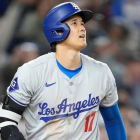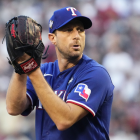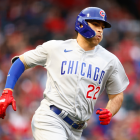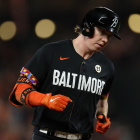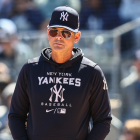Magic Johnson owning a share of the Los Angeles Dodgers makes a ton of sense. When it comes to making trades, no other Major League Baseball team looks more like an NBA team.
The Dodgers' latest NBA-style deal is a seven-player blockbuster with the Reds. L.A. traded outfielders Yasiel Puig and Matt Kemp, left-handed pitcher Alex Wood and catcher Kyle Farmer to Cincinnati. In return, the Dodgers acquired right-hander Homer Bailey, minor-league shortstop Jeter Downs and minor-league right-hander Josiah Gray.
At first glance, this looks like the kind of trade a rebuilding team would make, flipping three capable veteran players for a pair of prospects. The 28-year-old Puig hit a solid .267/.327/.494 with 23 home runs last season. The 34-year-old Kemp hit .290/.338/.481 with 21 long balls. The 27-year-old Wood pulled back a bit from his sparkling 2017 campaign, but still made 27 starts, posting a 3.68 ERA and a strikeout-to-walk rate better than 3 to 1.
These are the kind of solid support players a contender can often use as it vies for a deep playoff run. So why did the Dodgers ditch all three?
Simply, money. Puig is entering his final year before free agency and projects to make $12 million or more in arbitration. Kemp has one year at $21.75 million left on his enormous eight-year, $160 million contract. Wood is projected to make about $9 million in arbitration during his own walk year ahead of free agency. Though Puig, Kemp and Wood can all be positive contributors next season, $43 million is a steep price for a team to pay for the trio.
The Reds didn't actually risk much with this deal. They only added about $15 million in payroll (counting Bailey's $5 million 2020 option), and they don't sacrifice top prospects like Nick Senzel. For a team that sorely needed talent, they landed three solid players for $15 million, which is a reasonable gamble to take.
The Dodgers, though, are in a much different position than the Reds. Their owners, led by Mark Walter of insurance giant Guggenheim Partners, are rich in a way that no other teams' owners can claim to be. So what exactly is going on here?
To answer this question, we need to dig deeper into how Guggenheim does business, and how the Dodgers do business as a result.
Walter isn't your typical billionaire owner digging into his pockets to finance $200 million player contracts, stadium deals, and other investments. Instead, the Dodgers' record $2.15 billion purchase price in 2012 was funded in part by Guggenheim taking over a big chunk of the team in something akin to a loan deal, as opposed to a straight-up investment. In layman's terms, the Dodgers are using other people's money to finance (or at least to financially insure) much of their on-field moves, in the form of very large insurance funds.
Having a well of money that seemingly drills down to the Earth's crust enables the Dodgers to be financially aggressive, even reckless. As Steve Dilbeck wrote in the Los Angeles Times two years ago, in the three-and-a-half years since they signed Puig, the Dodgers spent nearly a quarter-billion dollars to buy Cuban players. Unless you're a die-hard fan of Cuban baseball (or watching money light on fire) you probably haven't seen many of these guys play. Hector Olivera, Alex Guerrero, Erisbel Arruebarrena, and many others turned into colossal busts, for both on-field and off-field reasons.
Thing is, the Dodgers believe they can use their financial clout to bet big on all kinds of players, then use the shrewd brains of their All-Star front office to dig out from under their mistakes. So far, they've been right about both. And they've often used NBA-style trades to make it all work.
In 2014, the Dodgers traded All-Star second baseman Dee Gordon and veteran right-hander Dan Haren to the Marlins in exchange for four young players: left-hander Andrew Heaney, infielder Enrique Hernandez, reliever Chris Hatcher, and minor-league catcher Austin Barnes. None of those players became stars in L.A. But each of them have had productive moments in the big leagues since then, with Hernandez and Barnes playing significant roles on the Dodgers teams that just went to the World Series two years in a row. The added bonus was ditching the eight-figure salary of Haren, a once-terrific pitcher who by then was nearing the end of his career.
The next season, the Dodgers sought to dump another player they didn't want. So they pulled off a three-team, 13-player, bonkers trade with the Marlins and Braves. Long story short, they ditched Olivera, a talented Cuban player who never panned out in the majors, and would ultimately land in jail for assault a year after the trade. In return they got a cavalcade of players, but the prize proved to be Wood, a talented young left-hander who would go on to blossom for the Dodgers.
Last winter, the Dodgers shipped out three players and a whole bunch of salary commitments, sending veteran pitchers Scott Kazmir and Brandon McCarthy as well as washed-up first baseman Adrian Gonzalez (and utility infielder Charlie Culberson) for Kemp, a player who'd gone from an MVP-caliber five-tool beast who once dated Rihanna to a player best suited for DH work, except he couldn't hit all that well anymore either. Kemp went on to enjoy a bounce-back season in L.A. before he was sent packing in today's trade.
Because the NBA operates with a soft (and punitive) salary cap, teams will often try to trade still-decent players to other teams, for the sole purpose of clearing payroll. They'll usually have to sacrifice additional assets to do so too, often in the form of draft picks.
The Dodgers have again and again found a way to foist unwanted contracts on other teams, while somehow snookering those other teams into also giving up useful talent -- often young and cheap and therefore valuable talent.
They might have just done it again on Friday. Baseball America recently named Downs the eighth-best prospect in the Reds system, pegging him as a capable hitter and speedy runner with a plus arm who could become a future everyday infielder in the majors. As the No. 32 overall pick in the 2017 draft, he's got pedigree on his side too. Gray was a second-round pick in this year's draft who struck out 59 batters and flashed a 2.58 ERA in 52 ⅓ innings in the rookie-level Appalachian League this summer.
This trade doesn't hinge on Downs or Gray breaking out in blue, though. What it does is, once again, clear a bunch of salary. The Dodgers plan to release Bailey, thus eating the $23 million he's owed in 2019, as well as a $5 million buyout for 2020. Even after that big expense, though, the Dodgers just greatly improved their balance sheet for the coming season.
This matters, because while the Dodgers theoretically have 800 bazillion dollars at their disposal, they worked hard to duck under the competitive-balance tax in 2018, thus resetting their status with the league to avoid paying escalating penalties. The Dodgers' current payroll sits just short of $160 million, with MLB Trade Rumors projecting nearly $17 million in arbitration awards for the players on the roster who are eligible for arbitration. Fill out the rest of the 40-man roster and the Dodgers could land around $185-$186 million with the current roster they've assembled, which includes just-signed flame-throwing setup man Joe Kelly. The competitive-balance tax threshold for 2019 is $206 million.
That means if status quo were to hold, the Dodgers could add about $20 million in salary for the coming season, and still avoid paying the tax. That money could be used for all kinds of goodies, including signing free-agent outfielder A.J. Pollock, or acquiring two-time Cy Young winner Corey Kluber or All-Star catcher J.T. Realmuto by trade. The Dodgers have reportedly looked into both scenarios. And in this trade with the Reds, L.A. managed to greatly improve its financial situation for the coming season without sacrificing any of their top prospects ... which keeps the door wide open for a potential Kluber or Realmuto deal.
Of course that's not the sexiest potential outcome there. That would be signing Bryce Harper to the biggest contract in baseball history.
There are multiple reasons to doubt a Harper deal coming to pass. For one thing, Harper is going to pull down an average salary that's much, much higher than $20 million a year. For another, the Dodgers under the new Andrew Friedman-led regime have emphasized youth, depth and outfoxing the competition through the use of data as the keys to the team's success. Other than re-upping franchise player and future Hall of Famer Clayton Kershaw, they've steered clear of spending to the moon on any one player. Giancarlo Stanton landed with the Yankees, Yu Darvish ended up on the Cubs, Yoenis Cespedes got his nine-figure deal from the Mets, and so on.
The counter to this strategy goes as follows: In both Tampa Bay and now in L.A., Friedman built ballclubs who pulled off lots of clever moves, banking a bushel of playoff berths as a result. Neither team, though, found a way to win it all. Acknowledging the brutal slog and random chance involved in navigating the postseason and finding a way to win the World Series, it's possible that Friedman's bosses (and maybe Friedman himself) have gotten tired of coming up just short.
Moreover, the Dodgers might be the third sports banana in Los Angeles right now. The rise of the Rams (and their ludicrously swanky new stadium on the way) has captured the imagination of the city's football fans. LeBron heading west sent an already Lakers-crazy town into a tizzy, with speculation now rumbling that Anthony Davis or another marquee name could come next. Given that the Dodgers have an $8.35 billion TV deal that further fuels their financial might, but with a screwed-up structure that prevents millions of Angelenos from watching their games, making a big free-agent splash could change things for the better.
Maybe the Dodgers are ready to be as aggressive (and possibly reckless) on the open market for major leaguers as they've been for Cuban players. Maybe Harper is that rare player who's actually young enough to justify that one, monster deal, since a free agent in his mid-20s possesses so much more upside than another in his 30s. Maybe the Dodgers could pull off one final bit of financial gymnastics, convincing Harper to accept tens of millions of dollars in deferred payments plus an early opt-out year in exchange for making his 2019 salary less onerous for competitive-balance tax purposes. Maybe the combination of World Series potential and the financial benefits of employing a megastar could prompt the Dodgers to do something very un-Dodgers-like, and spend $400 million for a single player.
The Dodgers are the most financially fascinating team in baseball, by a mile. By pulling off the one, big, honking, obvious move, maybe they'll finally become the most fascinating team on the field. And hopefully, finally, the best team in baseball too.


















